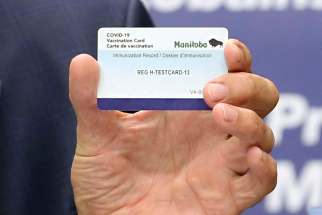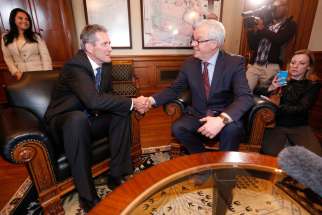Eagle feathers merit place in politics
Read this article for free:
or
Already have an account? Log in here »
To continue reading, please subscribe:
Monthly Digital Subscription
$0 for the first 4 weeks*
- Enjoy unlimited reading on winnipegfreepress.com
- Read the E-Edition, our digital replica newspaper
- Access News Break, our award-winning app
- Play interactive puzzles
*No charge for 4 weeks then price increases to the regular rate of $19.00 plus GST every four weeks. Offer available to new and qualified returning subscribers only. Cancel any time.
Monthly Digital Subscription
$4.75/week*
- Enjoy unlimited reading on winnipegfreepress.com
- Read the E-Edition, our digital replica newspaper
- Access News Break, our award-winning app
- Play interactive puzzles
*Billed as $19 plus GST every four weeks. Cancel any time.
To continue reading, please subscribe:
Add Free Press access to your Brandon Sun subscription for only an additional
$1 for the first 4 weeks*
*Your next subscription payment will increase by $1.00 and you will be charged $16.99 plus GST for four weeks. After four weeks, your payment will increase to $23.99 plus GST every four weeks.
Read unlimited articles for free today:
or
Already have an account? Log in here »
Hey there, time traveller!
This article was published 18/06/2021 (1634 days ago), so information in it may no longer be current.
The eagle feather is sacred in many Indigenous cultures in Canada because it is said the high-flying bird soars closest to the Creator.
A recent exchange between two Manitoba senators showed once again how much power the eagle feather holds and how Canadian politicians of all stripes and backgrounds must recognize how such a light item can carry so much weight.
On June 10, during a Senate debate about Bill C-15, which would enact the United Nations Declaration of the Rights of Indigenous Peoples into Canadian law, Senator Mary Jane McCallum took part in a Senate debate from Winnipeg using a video-conferencing app. She held a fan of eagle feathers while speaking against the bill, which she said is unclear and lacked teeth.
Senator Don Plett, the leader of the Opposition in the Senate, who also hails from Manitoba, called a point of order and asked the Senate’s speaker if the eagle feathers were a prop. Props, displays and exhibits are not allowed in debates in the Senate, the House of Commons and legislatures in Canada’s province’s and territories.
Ms. McCallum, who is a Cree survivor of residential schools, where teachers tried to strip students of their Aboriginal language and heritage, said the ceremonial object was given to her and that piece of Aboriginal culture wouldn’t be taken from her again.
The exchange caused a stir in the often-somnolent Red Chamber, and after a pre-scheduled dinner break, Mr. Plett withdrew the point of order and offered an apology, which Ms. McCallum accepted.
In this matter, the Senate’s unofficial motto of being a body for “sober second thought” needs particularly wise application.
Eagle feathers are no mere props, and Canada’s parliament, its legislatures and the Senate ought to allow Indigenous members to hold them during debates if they wish.
There were no questions about whether an eagle feather was appropriate when the last time one played a role in a Canadian political flap.
During the Meech Lake Accord constitutional debate in 1990, few, if any, questioned Elijah Harper’s decision to hold an eagle feather when he said “No,” and refused to provide the unanimous approval that was required to begin debate on the agreement in the Manitoba legislature.
Mr. Harper, who was the first person with Aboriginal treaty status to be elected to the legislature, said the pact failed to address Aboriginal rights and Indigenous groups weren’t consulted when Brian Mulroney, the prime minister, hammered out the deal with the country’s 10 premiers.
The refusal scuttled the accord and the photograph of Mr. Harper holding an eagle feather has become one of the most famous images in Canadian history.
In so doing, he proved to Canada’s Indigenous people that they finally did hold sway in the nation’s political process after decades of being forced to submit to politicians’ decisions and laws without having any say.
Eagle feathers are no mere props, and Canada’s parliament, its legislatures and the Senate ought to allow Indigenous members to hold them during debates if they wish.
Parliamentary partisans needn’t worry about the eagle feathers distracting from the sometimes raucous debates. Ms. McCallum and Mr. Harper held the eagle feathers with the honour and respect the ceremonial objects were bestowed and, if anything, they added reverence and some 21st-century relevance to the chambers’ dusty traditions.
In that way, the eagle feathers would also become a symbol that Indigenous people and those who represent them are welcome in the halls of Canada’s democracy, and not just bystanders forced to submit to the political process.





